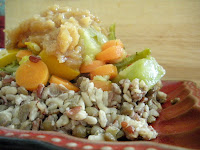 I'm not a vegan, although some days I could easily have people fooled. I have no problem with eggs, but I have a big problem with the way chickens are treated on factory farms; and since cruelty-free eggs are expensive, it's rare that I actually have eggs in the fridge. Luckily there are plenty of ways around it when I'm baking.
I'm not a vegan, although some days I could easily have people fooled. I have no problem with eggs, but I have a big problem with the way chickens are treated on factory farms; and since cruelty-free eggs are expensive, it's rare that I actually have eggs in the fridge. Luckily there are plenty of ways around it when I'm baking. 2 tbsp ground flaxseed + 6 tbsp warm waterThe results: Moist, dense, and delicious. I promise you, you won't notice the whole wheat flour and you won't miss the oil or the eggs. I used paper baking cups but I didn't let them cool before digging in (twice). As a result, my muffins stuck to the paper, but this could simply be because they weren't cool enough. If I have the same problem with the cooled ones tomorrow, I'll nix the cups and just oil the pans.
1 cup whole wheat flour
1/2 tsp baking soda
1/4 tsp salt
1/4 cup brown sugar
1/4 cup mashed apples (or unsweetened applesauce)2 medium ripe bananas, mashed
Preheat your oven to 325°F. Mix your flaxseed and water and let it soak, stirring occasionally, while you put the rest of the ingredients in a bowl. Add the flax-and-water mixture and mix everything well. Grease two muffin pans or line with paper baking cups. Fill 10 of the cups halfway and bake for 35 minutes, or until a toothpick inserted into the middle of a couple of the muffins comes out clean. Cool the pans on a wire rack, or if you used paper cups, remove them immediately and cool.
The skinny: Each muffin has 91 calories, 0.8 g fat, 123 mg sodium, 19.6 g carbohydrate, 1.4 g fiber, 7.1 g sugar, and 1.8 g protein. If you use 2 tbsp brown sugar instead of 1/4 cup (which I will be trying next time), each muffin has 84 calories, 17.9 g carbohydrate, and 5.4 g sugar. This makes each muffin count as 1 Weight Watchers Point for my parents :)
The alternatives: These muffins are admittedly small. I wanted something snack-size, but you could easily make half as many normal-sized muffins. You might just have to lower the temperature to 300 and increase the time by 10-15 minutes. I'll also try this the next time I make them to get the exact formula.




 The results: They look beautiful, if I do say so myself, golden brown and flour-dusted. The texture is very nice: soft with just the right amount of chewiness. They're very salty, however, and next time I'll definitely be cutting back to 1 teaspoon.
The results: They look beautiful, if I do say so myself, golden brown and flour-dusted. The texture is very nice: soft with just the right amount of chewiness. They're very salty, however, and next time I'll definitely be cutting back to 1 teaspoon.